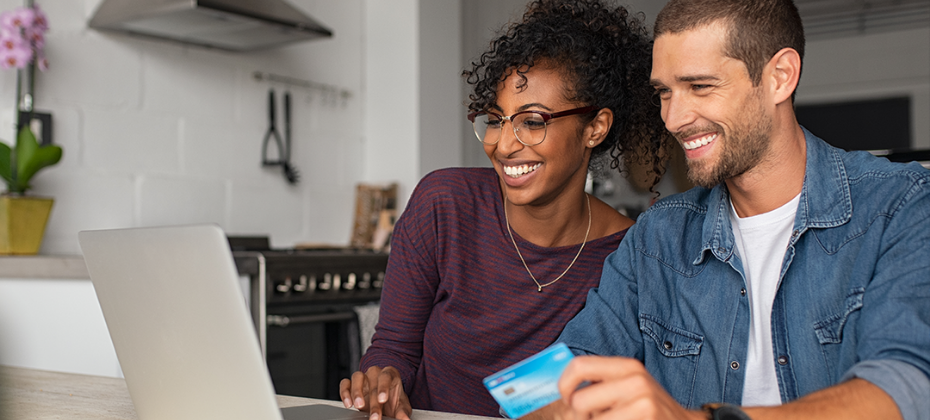Data & Analytics

Experian’s in-person Vision conference returns next Monday, April 11 in Los Angeles, Calif. The event is known for premier thought leadership, net-new insights and the latest and greatest in technology, innovation and data science. This year’s agenda promises to have intentional discussions around tomorrow’s trending topics including financial inclusion, buy now pay later, open banking, the future of fraud, alternative data strategies, and much more. A few spotlight sessions include: Top trends including the future application of the cloud and emerging technologies, emerging regulatory legislation and the broader implications and opportunities of DeFi. A deep dive into strategies around the targeting/marketing revolution and how to deliver in the post-COVID-19 market environments and bolster financial inclusion decisions. An introduction to Experian’s Buy Now Pay Later BureauTM, the industry’s first and only solution designed to address the needs of consumers, BNPL providers, financial institutions and regulators alike. A roundup of sessions addressing innovation in action spanning from real-time verifications, to data-driven automation, and unified platforms from data to deployment to decisioning. Several sessions highlighting future-looking strategies and solutions that leverage alternative data that can increase conversion rates while concurrently reducing risk. Multiple sessions centered on the rapidly changing identity environment and combatting emerging fraud threats. The event will also include a Tech Showcase, where attendees can get a taste of tomorrow today with more than 20 demos and the latest innovations at their fingertips. And, as always, the event features marquee keynote speakers sure to inspire. This year’s featured speakers are Dr. Mohamed A. El-Erian, President of Queens’ College, Cambridge, Chief Economic Advisor at Allianz, and Former CEO and Co-Chief Investment Officer of PIMCO; Allyson Felix, Olympic Gold Medalist, co-founder of Saysh, a footwear and lifestyle brand for women, and Right to Play and Play Works ambassador; and the closing keynote will feature actor, investor, entrepreneur and philanthropist, Ashton Kutcher. Stay tuned for additional highlights and insights on our social media platforms throughout the course of the conference. Follow Experian Insights on Twitter and LinkedIn.

For decades, the credit scoring system has relied on traditional data that only examines existing credit captured on a credit report – such as credit utilization ratio or payment history – to calculate credit scores. But there's a problem with that approach: it leaves out a lot of consumer activity. Indeed, research shows that an estimated 28 million U.S. adults are “credit invisible," while another 21 million are “unscorable."1 But times are changing. While conventional credit scoring systems cannot generate a score for 19 percent of American adults,1 many lenders are proactively turning to expanded FCRA-regulated data – or "alternative data" – for solutions. Types of expanded FCRA-regulated data By tapping into technology, lenders can access expanded FCRA-regulated data, which offers a powerful and complete view of consumers' financial situations. Expanded public record data This can include professional and occupational licenses, property deeds and address history – a step beyond the limited public records information found in standard credit reports. Such expanded public record data is available through consumer reporting agencies and does not require the customer's permission to use it since it's a public record.1 “Experian has partnerships with these agencies and can access public records that provide insight into factors like income and housing stability, which have a direct correlation with how they'll perform," said Greg Wright, Chief Product Officer for Experian Consumer Information Services. “For example, lenders can see if a consumer's professional license is in good standing, which is a strong correlation to income stability and the ability to pay back a loan." Rental payment data Experian RentBureau draws updated rental payment history data every 24 hours from property managers, electronic rent payment services and collection companies. It can also track the frequency of address changes. “Such information can be a good indicator of risk," said Wright. “It allows lenders to make informed judgments about the financial health and positive payment history of consumers." Consumer-permissioned data With permission from consumers, lenders can look at different types of financial transactions to assess creditworthiness. Experian Boost™, for example, enables consumers to factor positive payment history, such as utilities, cell phone or even streaming services, into an Experian credit file. “Using the Experian Boost is free, and for most users, it instantly improves their credit scores," said Wright. “Overall, those 'boosted' credit scores allow for fairer decisioning and better terms from lenders – which gives customers a second chance or opportunity to receive better terms." Financial Management Insights Financial Management Insights considers data that is not captured by the traditional credit report such as cash flow and account transactions. For instance, this could include demand deposit account (DDA) data, like recurring payroll deposits, or prepaid account transactions. “Examining bank account transaction data, prepaid accounts, and cash flow data can be a good indicator of ability to pay as it helps verify income, which gives lenders insights into consumers' cash flow and ability to pay," Wright added. Clarity Credit Data With Experian's Clarity Credit Data, lenders can see how consumers use expanded FCRA-regulated data along with their related payment behavior. It provides visibility into critical non-traditional loan information, including more insights into thin-file and no-file segments allowing for a more comprehensive view of a consumer's credit history. Lift Premium™ By using multiple sources of expanded FCRA-regulated data to feed composite scores, along with artificial intelligence and machine learning, Lift Premium™ can vastly increase the number of consumers who can be scored. For example, research shows that Lift Premium™ can score 96 percent of American adults – a significant increase from the 81 percent that are scorable with conventional scores relying on only traditional credit data. Additionally, such enhanced composite scores could enable 6 million of today's subprime population to qualify for “mainstream" (prime or near-prime) credit.1 How is expanded FCRA-regulated data changing the credit scoring system? The current credit scoring system is rapidly evolving, and modern technology is making it easier for lenders to access expanded FCRA-regulated data. Indeed, this data disruption is changing lender business in a positive way. “When lenders use expanded credit data assets, they see that many unscorable and credit invisible consumers are in fact creditworthy," said Wright. “Layering in expanded FCRA-regulated data gives a clearer picture of consumers' financial situation." By expanding data assets, tapping into artificial intelligence and machine learning, lenders can now score many more consumers quickly and accurately. Moreover, forward-thinking lenders see these expanded data assets as offering a competitive edge: it's estimated that modern credit scoring methods could allow lenders to grow their pool of new customers by almost 20 percent.1 Case study: Consumer-permissioned data To date, over 9 million people have used Experian Boost. The technology uses positive payment history as a way to recognize customers who exhibit strong credit behaviors outside of traditional credit products. “Boosted" consumers were able to add on average 14 points to their FICO scores in 2022 so far, making many eligible for additional financial products with better terms or better product offerings. Active Boost consumers, post new origination performed on par or better than the average U.S. originator, consistently over time. “In other words, having this additional lens into a consumer's financial health means lenders can expand their customer base without taking on additional credit risk," explains Wright. The bottom line The world of credit data is undergoing a revolution, and forward-thinking lenders can build a sound business strategy by extending credit to consumers previously excluded from it. This not only creates a more equitable system, but also expands the customer base for proactive lenders who see its potential in growing business. Learn more 1Oliver Wyman white paper, “Financial Inclusion and Access to Credit,” January 12, 2022.

At Experian, we know that financial institutions, fintechs and lenders across the entire spectrum – small, medium and large, are further exploring and adopting AI-powered solutions to unlock growth and improve operational efficiencies. With increasing competition and a dynamic economy, AI-driven strategies across the entire customer lifecycle are no longer a nice to have, they are a must. Our dedication to delivering on this need for our clients is why we are thrilled to be recognized as a Fintech Breakthrough Award winner for the fifth consecutive year. Experian’s Ascend Intelligence ServicesTM (AIS) platform hosts a suite of analytics solutions and has been named “Best Consumer Lending Product” in the sixth annual FinTech Breakthrough Awards. This awards program is conducted by FinTech Breakthrough, an independent market intelligence organization that recognizes the top companies, technologies and products in the global fintech market today. This is the second consecutive year that AIS has been recognized with a FinTech Breakthrough Award, previously being selected for the “Consumer Lending Innovation Award” in 2021. “Winning another award from FinTech Breakthrough is a fantastic validation of the success and momentum of our Ascend Intelligence Services suite. Now more than ever, the world is in a state of constant change and companies are being reactive, with data scientists spending too much time on manual, repetitive data-wrangling tasks, at a time when they cannot afford to do so,” said Shri Santhanam, Experian’s executive vice president and general manager of Global Analytics and AI. “Companies need to be able to rapidly develop and deploy ML-powered models in an agile way at low cost. We are now able to offer this to more lenders no matter their size.” With AIS, Experian can empower financial services firms to make the best decisions across the customer life cycle with rapid model and strategy build, seamless deployment, optimization and continuous monitoring. The AIS suite is comprised of two key solution models: Ascend Intelligence Services Acquire is a managed services offering that enables financial institutions to increase approval rates and control bad debt by acquiring the right customers and providing the best offers. This is accomplished through a rapid AI/ML model build that will help better quantify the risk of an individual applicant. Next, a mathematically optimized decision strategy is designed to provide a more granular view of the applicant and help make the best decision possible based on the institution’s specific business goals and constraints. The combination of the AI/ML model and optimized decision strategy provides increased predictive power that mitigates risk and allows more automated decisions to be made. The model and strategy are seamlessly deployed to help deliver business value quickly. Ascend Intelligence Services™ Limit enables financial institutions to make the right credit limit decisions at account origination and during account management. Limit uses Experian’s data, predictive risk and balance models and our powerful optimization engine to design the right credit limit strategy that maximizes product usage, while keeping losses low. To learn more about how Ascend Intelligence Services can support your business, please explore our solutions page. Learn more For a list of all award winners selected for the 2022 FinTech Breakthrough Awards, click here.

In today’s evolving and competitive market, the stakes are high to deliver both quantity and quality. That is, to deliver growth goals while increasing customer satisfaction. OneAZ Credit Union is the second largest credit union in Arizona, serving over 157,000 members across 21 branches. Wanting to fund more loans faster and offer a better member experience through their existing loan origination system (LOS), OneAZ looked to improve their decisioning system and long-standing underwriting criteria. They partnered with Experian to create an automated underwriting strategy to meet their aggressive approval rate and loss rate goals. By implementing an integrated decisioning system, OneAZ had flexible access to data credit attributes and scores, resulting in increased automation through their existing LOS – meaning they didn’t have to completely overhaul their decisioning systems. Additionally, they leveraged software that enabled champion/challenger strategies and the flexibility to manage their decision criteria. Within one month of implementation, OneAZ saw a 26% increase in loan funding rates and a 25% decrease in manual reviews. They can now pivot quickly to respond to continuously evolving conditions. “The speed at which we can return a decision and our better understanding of future performance has really propelled us in being able to better serve our members,” said John Schooner, VP Credit Risk Management at OneAZ. Read our case study for more insight on how automation and PowerCurve Originations Essentials can move the needle for your organization, including: Streamlined strategy development and execution to minimize costly customizations and coding Comprehensive data assets across multiple sources to ensure ID verification and a holistic view of your prospect Proactive monitoring and real-time visibility to challenge and rapidly adjust strategies as needed Download the full case study

We recently collaborated with our integration partner, TrueCar, to analyze vehicle history data's impact on online listings. We analyzed millions of records over months of data and matched online listings to DMS sales to confirm closing rates. The short story – dealership Vehicle Detail Pages (VDPs) on TrueCar.com that offer consumers a Free Experian AutoCheck vehicle history report had a higher lead conversion rate. We expected the data to confirm that VDPs with a Free VHR would have a higher lead conversion rate. However, we uncovered additional insights that even surprised us! The most common search filter Consumers value transparency from a dealership and expect to be informed if a vehicle they are looking at has been in an accident. We learned from the study that when consumers used vehicle history data to filter their user's search results, the “accident” filter was the most common vehicle history data filter used. More than one-third of consumers using vehicle history data to filter search results use “accident” as a filter criterion. Why is this important? There are over 280 million vehicles in operation, and four out of ten of those vehicles have been in an accident. That means more than 100 million vehicles on the road have been in an accident—and 20% of vehicles on the road have had multiple events. Higher conversion rates (with a twist) Having been in the automotive data and analytics space for years, we were not surprised that the analysis continued to support our previous research that vehicle detail pages with a free vehicle history report have a higher lead conversation rate! Things started to get even more interesting, though: VDPs with a free AutoCheck VHR converted at a 27% higher rate. That holds true if the VDP page had a Free AutoCheck report available to the consumer, but if the consumer clicked on the free AutoCheck vehicle history report to view the details of the information, the lead conversion rate jumped to 318% (no, that’s not a typo). The lead conversion rate increased to 318% if the consumer viewed the AutoCheck vehicle history report! VDP sale conversion rates And while we all appreciate a good lead conversion success story, we also wanted to analyze sale conversion rates. We learned that TrueCar VDPs that offered consumers a Free AutoCheck vehicle history report on behalf of a dealership had a higher sales conversion rate. Not only is the rate higher—the sale conversion rate is 50% higher for VDPs that offer a free VHR. Here are a few more interesting pieces of information we uncovered with this latest analysis: VDP’S without an accident close at about 200% higher than those with an accident Vehicles without frame damage had a 250% greater close rate Vehicles without a salvage indicator had a 634% greater close rate Consumers want to make informed decisions when purchasing vehicles, and automotive dealerships can help by providing them with a free AutoCheck Vehicle History Report on every Vehicle Detail Page. Help improve lead conversation rates, sale conversation rates, and build customer trust by offering vehicle history transparency. For dealers with an AutoCheck subscription, you can activate your vehicle listings for free on TrueCar by calling AutoCheck Customer Service at 1 888 409 2204. Dealers interested in learning more about the benefits of becoming an AutoCheck subscriber, contact us today!

As credit volumes recover from lows observed in 2021, lenders face new challenges – from increasing demand in customer expectations, to heightened competition, market volatility and a fierce war on talent. Many lenders have incorporated the foundational elements of credit analytics and seen significant initial returns. Now, it’s time for lenders to unlock even greater growth opportunities and operational efficiencies by exploring AI-powered solutions. Experian presented on a recent webinar hosted by Lendit Fintech, where Srikanth Geedipali, Senior Vice President of Global Analytics and AI for Experian, joined a panel of industry experts with representation from OPY and Citibank, to speak on how lenders can differentiate themselves by unlocking the power of advanced technologies such as AI and ML to address these emerging challenges. Watch the full webinar, NextGen Applications of AI in the Credit Lifecycle, and learn more about: Emerging trends in the AI/ML space that will drive innovation and differentiated solutions Use-cases for AI/ML across the lending lifecycle and how to leverage MLOps to industrialize analytics and improve speed and agility of decision-making How advanced technologies have driven impact for lenders of all sizes This webinar is a part of Lendit Fintech’s webinar series. To learn more about how leveraging AI/ML can help optimize your lending strategies, contact us today. Learn more about Ascend Intelligence Services

The automotive marketing world has benefited from cookie-based information to help identify and reach consumers in the market for a vehicle. Now that cookies will be going away, marketers need to find alternate ways to find in-market consumers. Let’s explore. What are cookies? Created to personalize internet browsing experiences, cookies are small pieces of code placed within a user’s browser whenever someone visits a specific website. Cookies typically track the website’s name and a generated unique user ID. They can capture page clicks, viewed web pages, clicks within a website, and Personally Identifiable Information (PII) such as an address, name, and device IDs. How are cookies used in marketing? Cookie data helps automotive marketers enhance the user experience by better understanding consumer behaviors to deliver targeted, relevant messaging that moves the consumer through the buying funnel. For example, think about when a consumer researches RVs/travel trailers to see if their current vehicle can handle towing a camper or when they search for the best way to hook up a camper. A dealer could use this cookie data to send advertisements for trucks with a towing package that could potentially tow a trailer. Cookie support is ending, so now what? In 2020, Google announced it would end support for cookies in the Chrome browser by early 2022. This timeline was established to allow Google to address the needs of users, publishers, and advertisers to respond and look for workarounds. The revised timeline puts Google’s cookie retirement in 2023. Marketers have been using cookie data in advertising for years, so what are the options when cookie data goes away? Cookie alternatives Automotive marketers can tackle a cookie-less world by using other sources of consumer data insights. For instance, a third-party data aggregator, like Experian, has access to numerous sources, platforms, and websites. Beyond that, we have access to a vast range of specific consumer data insights, including vehicle ownership, registrations, vehicle history data, and lending data. We take all that information and help marketers segment audiences and predict what consumers will do next. (That’s more than the average cookie!) Sample audience segment information: Consumers in market Loan status In positive equity Driving a specific year/make/model 1000+ lifestyle events such as new baby, marriage, new home Geography, demographics, psychographics To take it to the next level, we can use predictive analytics to go beyond what cookie data could provide by predicting who is ready to purchase a vehicle. In our example above, a marketer used cookie data to find buyers who had shown interest in a tow package, but that’s where it ended. By combining audience segmentation with a predictive model, marketers can target and identify consumers in-market and most likely ready to purchase a vehicle with a tow package. In this way, the data-driven insights from a third-party data provider specializing in automotive insights can replace the cookie-driven approach and take it a significant step beyond. Other ways to reach consumers in a cookie-less world Automotive marketers can also use data-driven insights to further explore specific channels where consumers spend their time. Social media, for example, is an effective channel to reach consumers. Marketers can go beyond standard Facebook audiences by utilizing Experian audience segmentation and predictive analytics to highly target consumers on Facebook. So, if you can predict when a consumer will be in-market, and you know in what channel they spend most of their time, you can target them with specific messages about your dealership and your vehicles. With cookies becoming a tool of the past, knowing who is likely to be in-market, what message resonates with them, and the best channel to use allows marketers to move beyond cookie-based strategies effectively. So, let the cookie crumble! For a deeper dive into cookies, watch this recorded webinar from the 2021 Digital Marketing Strategies conference: As the Cookies Crumble, How Will Automotive Digital Marketing Respond? Presented by Experian's Amy Hughes, Sr. Director of Dealer Intelligence. Learn more about Experian’s Automotive Intelligence Engine and how audience segmentation and predictive analytics can drive more in-market buyers to your dealership.

There are many facets to promoting a more equitable society. One major driver is financial inclusion or reducing the racial wealth gap for underserved communities. No other tool has impacted generational wealth more than sustainable homeownership. However, the underserved and underbanked home buyers experience more barriers to entry than any other consumer segment. It is important to recognize the well-documented racial and ethnic homeownership gap; doing so will not only benefit the impacted communities, but also elevate the level of support of those lenders who serve them. What are we doing as an industry to reduce this gap? Many organizations are doing their part in removing barriers to homeownership and systemic inequities. In 2021, the FHFA published their Duty to Serve 2021 plans for Fannie Mae and Freddie Mac to focus on historically underserved markets. A part of this plan includes increasing liquidity of mortgage financing for lower- and moderate-income families. Fannie Mae and Freddie Mac each announced individual refinance offerings for lower-income homeowners – Fannie Mae’s RefiNow™ and Freddie Mac’s Refi PossibleSM. Eligible borrowers meet requirements including income at or below 100% area median income (AMI), a minimum credit score of 620, consideration for loans in forbearance and additional newly expanded flexibilities. As part of the plan, lenders will lower a borrower’s monthly payment by at least a half a percentage point reduction in their interest rate, which can translate into hundreds of dollars of savings per month and sustain their homeownership. Experian has the tools to help mortgage lenders take advantage of this offering As a leader in data, analytics and technology, we have the tools needed to help lenders recognize opportunities to be inclusive and identify borrowers who may be eligible for Fannie Mae’s and Freddie Mac’s lower-income refinance offerings. To illustrate, we performed a data study and identified over 6M eligible mortgages nationwide (impacting over 8M borrowers) for this plan, and some lenders had as much as 30% of mortgages in their portfolio eligible with lower- and moderate-incomes.1 These insights can have a positive impact on the borrowers you serve by promoting more inclusion and benefit lenders through improved customer retention, strengthened customer loyalty and an opportunity to continue to build generational wealth through housing. We are committed to enabling the industry's DEI evolution As the Consumer’s bureau, empowering consumers is at the heart of everything we do. We’re committed to developing products and services that increase credit access, greater inclusion in homeownership and narrowing the racial wealth gap. Below are a few of our recent initiatives, and be sure to check out our financial inclusion resources here: United for Financial Health: Promotes inclusion in underserved communities through partnerships and have committed to investing our time and resources to create a more inclusive tomorrow for our communities. Project REACh (Roundtable for Economic Access and Change): brings together leaders from banking, business, technology, and national civil rights organizations to reduce barriers that prevent equal and fair participation in the nation’s economy, and we are engaged with the Alternative Credit Scoring Utility group as part of this initiative. Operation Hope: Empowers youth and underserved communities to improve their financial health through education, so they can thrive (not just survive) in the credit ecosystem so they can sustain good credit and responsibly use credit. DEI-Centric Solutions: From Experian Boost to our recent launch of Experian Go, we offer a variety of consumer solutions designed to empower consumers to gain access to credit and build a brighter financial future. What does this mean for you? Our passion, knowledge and partnerships in DEI have enabled us to share best practices and can help lenders prescriptively look at their portfolios to create inclusive growth strategies, identify gaps, and track progress towards diversity objectives. The mortgage industry has a unique opportunity to create paths to homeownership for underserved communities. Together, we can drive impact for generations of Americans to come. Let’s drive inclusivity and revive the American dream of homeownership. 1Experian Ascend™ as of November 2021

As more consumers apply for credit and increase their spending1, lenders and financial institutions have an opportunity to expand their portfolios and improve profitability. The challenge is ensuring they’re extending credit responsibly and inclusively. Millions of Americans, many of whom are creditworthy, lack access to mainstream credit options. This may be because they have limited or no credit history, negative information within their credit file, or are a part of a historically disadvantaged group. To say “yes” to consumers they otherwise couldn’t or wouldn’t lend to, lenders must gain a deeper understanding of an individual’s stability, ability and willingness to pay. That’s where expanded FCRA-regulated and trended data come in. While traditional credit data has long been the primary means of gauging creditworthiness, it doesn’t tell the full story of a consumer’s financial situation. Let’s explore how differentiated data can help lenders make more informed credit decisions. Using differentiated data for deeper lending Expanded FCRA-regulated data provides supplemental credit data to help lenders gain a more holistic view of their current and prospective customers. Some examples of expanded FCRA-regulated data include alternative financial services data from nontraditional lenders, consumer-permissioned account data, rental payments and full-file public records. Because this data drives greater visibility and transparency around inquiry and payment behaviors, lenders can more accurately determine a consumer’s ability to pay and distinguish between reliable and high-risk applicants. In turn, lenders can approve more creditworthy consumers, grow their portfolios and increase financial opportunities for underserved communities, all while preventing and mitigating risk. 89% of lenders agree that expanded FCRA-regulated data allows them to extend credit to more consumers. Trended data empowers lenders with predictive insights into consumers by providing key balance and payment data for the previous 24 months. This is important as lenders can determine if a consumer’s credit behavior has improved or deteriorated over time. In turn, lenders can: Identify creditworthy customers: Establish if a consumer has a demonstrated ability to pay, is consistently paying more than the minimum payment, or shows no signs of payment stress. Increase response rates: Match the right products with the right prospects. Determine upsell and cross-sell opportunities: Present relevant offers based on anticipated needs and behaviors. Limit loss exposure: Understand the direction and velocity of payment performance to effectively manage risk exposure. Trended data helps lenders better predict future behavior, manage portfolio risk and design the best marketing offers. Turning insights into action Together, trended and expanded FCRA-regulated data benefit lenders and consumers alike. With a more holistic view of their customers, lenders gain powerful insights to lend deeper, ultimately helping them to expand their portfolios and drive greater access to credit for underserved communities. Learn more 1 The Recovery of Credit Applications to Pre-Pandemic Levels, Consumer Financial Protection Bureau, 2021.

Lenders are under pressure to improve access to financial services, but can it also be a vehicle for driving growth? With the global pandemic and social justice movements exposing societal issues of equity, financial institutions are being called upon to do their part to address these problems, too. Lenders are increasingly under pressure to improve access to the financial system and help close the wealth gap in America. Specifically, there are calls to improve financial inclusion – the process of ensuring financial products and services are accessible and affordable to everyone. Financial inclusion seeks to remove barriers to accessing credit, which can ultimately help individuals and businesses create wealth and elevate communities. Activists and regulators have singled out the current credit scoring system as a significant obstacle for a large portion of U.S. consumers. From an equity standpoint, tackling financial inclusion is a no-brainer: better access to credit allows more consumers to secure safer housing and better schools, which could lead to higher-paying jobs, as well as the ability to start businesses and get insurance. Being able to access credit in a regulated and transparent way underpins financial stability and prosperity for communities and is key to creating a stronger economic system. Beyond “doing the right thing," research shows that financial inclusion can also fuel business growth for lenders. Get ahead of the game There is mounting regulatory pressure to embrace financial inclusion, and financial institutions may soon need to comply with new mandates. Current lending practices overlook many marginalized communities and low-income consumers, and government agencies are seeking to change that. Government agencies and organizations, such as the Consumer Financial Protection Bureau (CFPB) and Office of the Comptroller of the Currency (OCC), are requiring greater scrutiny and accountability of financial institutions, working to overhaul the credit reporting system to ensure fairness and equality. As a lender, it makes good business sense to tackle this problem now. For starters, as more institutions embrace Corporate Social Responsibility (CSR) mandates—something that's increasingly demanded by shareholders and customers alike—financial inclusion is a natural place to start. It demonstrates a commitment to CSR principles and creates a positive brand built on equity. Further, financial institutions that embrace these changes gain an early adopter advantage and can build a loyal customer base. As these consumers begin to build wealth and expand their use of financial products, lenders will be able to forge lifelong relationships with these customers. Why not get a head start on making positive organizational change before the law compels it? Grow your business (and profits) To be sure, financial inclusion is a pressing moral imperative that financial institutions must address. But financial inclusion doesn't come at the expense of profit. It represents an enormous opportunity to do business with a large, untapped market without taking on additional risk. In many instances, unscorable and credit invisible consumers exhibit promising credit characteristics, which the conventional credit scoring system does not yet recognize. Consider consumers coming to the U.S. from other countries. They may have good credit histories in their home countries but have not yet established a credit history here. Likewise, many young, emerging consumers haven't generated enough history to be categorized as creditworthy. And some consumers may simply not utilize traditional credit instruments, like credit cards or loans. Instead, they may be using non-bank credit instruments (like payday loans or buy-now-pay-later arrangements) but regularly make payments. Ultimately, because of the way the credit system works, research shows that lenders are ignoring almost 20 percent of the U.S. population that don't have conventional credit scores as potential customers. These consumers may not be inherently riskier than scored consumers, but they often get labelled as such by the current credit scoring system. That's a major, missed opportunity! Modern credit scoring tools can help fill the information gap and rectify this. They draw on wider data sources that include consumer activities (like rent, utility and non-bank loan payments) and provide holistic information to assist with more accurate decisioning. For example, Lift Premium™ can score 96 percent of Americans with this additional information—a vast improvement over the 81 percent who are currently scored with conventional credit data.1 By tapping into these tools, financial institutions can extend credit to underserved populations, foster consumer loyalty and grow their portfolio of profitable customers. Do good for the economy Research suggests that financial inclusion can provide better outcomes for both individuals and economies. Specifically, it can lead to greater investment in education and businesses, better health, lower inequality, and greater entrepreneurship. For example, an entrepreneur who can access a small business loan due to an expanded credit scoring model is subsequently able to create jobs and generate taxable revenue. Small business owners spend money in their communities and add to the tax base – money that can be used to improve services and attract even more investment. Of course, not every start-up is a success. But if even a portion of new businesses thrive, a system that allows more consumers to access opportunities to launch businesses will increase that possibility. The last word Financial inclusion promotes a stronger economy and thriving communities by opening the world of financial services to more people, which benefits everyone. It enables underserved populations to leverage credit to become homeowners, start businesses and use credit responsibly—all markers of financial health. That in turn creates generational wealth that goes a long way toward closing the wealth gap. And widening the credit net also enables lenders to uncover new revenue sources by tapping new creditworthy consumers. Expanded data and advanced analytics allow lenders to get a fuller picture of credit invisible and unscorable consumers. Opening the door of credit will go a long way to establishing customer loyalty and creating opportunities for both consumers and lenders. Learn more

Credit scores hold the key to many aspects of our financial lives. Whether qualifying for a mortgage, insurance, or a smartphone plan, financial institutions rely on credit reports — a document detailing how responsibly a person has used credit accounts in the past — to decide if they should approve your financing application. However, here's the problem: because today's scoring system leans heavily on a person’s credit history to generate a credit score, it leaves out large segments of the United States population from accessing credit. According to a recent Oliver Wyman report, an estimated 28 million U.S. consumers are considered ”credit invisible," while another 21 million are deemed "unscorable," meaning they don’t have the types of accounts that have been traditionally used to generate a credit score. Using the traditional credit-scoring formula, certain populations, such as communities of color and low-income consumers, are left behind. Now, times are changing. A modern approach to credit scoring can significantly improve the financial inclusion of millions of U.S. consumers and correct past and present inequities. Tapping into advanced technologies that leverage expanded data assets can produce powerful results. A cycle of exclusion: The limitations of conventional credit scoring A big part of the problem lies with how credit scores are calculated. Between payment history and length of accounts held, a consumer’s credit history accounts for 50 percent of a FICO credit score — the credit score used by 90 percent of top lenders for credit decisions. In other words, the credit system rewards people who already have (or can get) credit and penalizes those that cannot or don't yet have credit. For those who do not have credit, their financial behaviors — such as timely rental and utility payments, bank account data and payday loan installment payments — may not get reported to credit bureaus. As a result, consumers without a credit history may appear as credit invisible or unscorable because they don't have enough tradelines to generate a score. But they also can’t get credit to improve their score. It creates a cycle of exclusion that’s hard to break. Who gets left behind? According to the latest research, the limitations on the traditional credit scoring system disproportionately impact certain communities: Low-income: 30 percent of those in low-income neighborhoods are credit invisible, and 16 percent are considered unscorable, compared with just 4 percent and 5 percent, respectively, in upper-income neighborhoods.1 Communities of color: 27 percent of Black and 26 percent of Hispanic consumers are either credit invisible or unscorable, while only 16 percent of white consumers are.1 Immigrants: People who have recently arrived in the United States can lack a credit history here, even if they may have had one in their home country. Meanwhile, undocumented immigrants, who don’t have a Social Security number, can find it difficult to get a credit card or use other financial services. Young adults: 40 percent of credit invisibles in the U.S. are under the age of 25,1 with 65 percent of 18- to 19-year-olds lacking a credit score. Being labeled unscorable or credit invisible can hinder participation in the financial system and prevent populations from accessing the socioeconomic opportunities that go with it. Why are certain individuals and communities excluded? There are often complex — and valid — reasons for why many consumers are deemed unscorable or credit invisible. For example, newcomers may appear to be credit invisible because haven’t yet generated a credit history in the U.S., although they may have a solid score in their home country. Young consumers are also a common category of unscorable or credit invisible people, largely because they haven't acquired credit yet. Only 35 percent of 18- to 19-year-olds have a credit score, while 91 percent of 25- to 29-year-olds do. However, those who can quickly get a credit history typically come from wealthier households, where they can rely on a creditworthy guarantor to help them establish credit. Finally, some consumers have had negative experiences with the financial system. For instance, a prior default can make it difficult to access credit in the future, which can result in an extended period without credit, eventually leading to being labelled unscorable. Others may distrust the mainstream financial system and choose not to participate. Underpinning all this are racial disparities, with Black and Hispanic consumers being classified as unscorable and credit invisible at significantly higher rates than white and Asian consumers. According to the Consumer Financial Protection Bureau (CFPB), Black and Hispanic people, as well as low-income consumers, are more likely to have “scant or non-existent” credit histories. Financial inclusion is an equity issue Traditional credit scoring places big barriers on certain communities. Without access to credit, marginalized communities will continue to face challenges. They will lack the ability to purchase property, secure business and/or personal loans and deal with financial emergencies, further widening the wealth gap. Since credit scores are used to decide loan eligibility and what interest rate to offer, those with low or no credit rating tend to pay higher interest rates or are denied desired loans, which compounds financial difficulty. The impact is profound: a significant percentage of the population struggles to access basic financial services as well as life opportunities, such as financing an education or buying a home. Without the ability to generate a credit score, unscorable or credit invisible consumers often turn to less-regulated financial products (such as payday loans or buy now pay later agreements) and pay more for these, often locking them in a vicious cycle. Consumers who are credit invisible or unscorable often end up paying more for everyday transactions. They may be required to put up hefty deposits for housings and utilities. Auto and homeowners insurance, which use credit score as a factor in setting rates, may be more expensive too. Consider how much this could impede someone’s ability to save and build generational wealth. Financial inclusion seeks to bring more consumers into the financial system and enable access to safe, affordable financial services and products. With the right technology on your side, there are solutions that make it easier to do so. Tap into technology Banks, credit unions and other lending institutions are well positioned to move the needle on financial inclusion by embracing expanded definitions of creditworthiness. By seeking out expanded FCRA-regulated data with wider sources of financial information, financial institutions can find a vast untapped pool of creditworthy consumers to bring into the fold. Technology makes achieving this goal easier than ever. New credit scoring tools, like Lift Premium™, can give lenders a more complete view of the consumer to use for credit decisioning. It combines traditional credit data with expanded FCRA-regulated data sources, helping lenders uncover more creditworthy consumers. Lift Premium can score 96 percent of U.S. consumers, compared to just 81 percent that conventional scoring systems do now. By applying machine learning to expanded data sets, Lift Premium can build a fuller and more accurate view of consumer behaviors. Moreover, the 6 million consumers whose scores are now considered subprime could be upgraded to prime or near-prime by analyzing the expanded data that Lift Premium uses. The opportunity presented by financial inclusion is significant. Imagine being able to expand your portfolio of creditworthy borrowers by almost 20 percent. The last word With a renewed focus on social justice, it’s no surprise that regulators and activists alike are turning their attention to financial inclusion. A credit-scoring system that allows lenders to better evaluate more consumers can give more people access to transparent, cheaper and safer financial products and the socioeconomic benefits that go along with them. New models and data assets offer additional data points into the credit scoring system and make it possible for lenders to expand credit to a greater number of consumers, in the process creating a fairer system than exists today. Early adopter lenders who embrace financial inclusion now can gain a first-mover advantage and build a loyal customer base in a competitive market. Learn more Download white paper 1Oliver Wyman white paper, “Financial Inclusion and Access to Credit,” January 12, 2022.

Since January 27, 2020, the federal government has been operating under a Public Health Emergency (PHE) related to the COVID-19 pandemic. On January 14, 2022, this PHE was renewed for an eighth time. While we are currently in the midst of the omicron surge, some suggest that we may be nearing the beginning of the end of the pandemic — and thus the inevitable expiration of the PHE. Impacts of the PHE While the PHE remains in effect, states must maintain current Medicaid enrollees, regardless of changes to their eligibility status. A recent report showed Medicaid enrollment increased 16.8% from February 2020 to June 2021. This is counter to the previous trend, where enrollment declined from 2017 to 2019. Furthermore, the average per capita Medicaid cost to states is estimated at $5K–$10K (states share about one-third of the cost of Medicaid). The combination of the per capita expense and the increased number of enrollees during the pandemic translates to a significant impact on state budgets. Once the federal order expires, states will have 12 months to redetermine eligibility for continued enrollment in the program, or risk bearing 100% of the associated cost. Processing redetermination in a timely manner is critical for states to avoid unnecessary expenditures and to ensure that citizens are receiving access to the correct services. It’s imperative that states start planning for redetermination of benefits for continued Medicaid coverage as soon as possible to be prepared to take action at the inevitable conclusion of the PHE. Preparing for redeterminations At the end of the PHE, states will need a system to easily and confidently review their current Medicaid rolls to confirm eligibility. Implementing this system will likely involve working with a trusted partner who can provide tools and advantages such as: Portfolio analysis Real-time analysis Verification of income and employment Compliance adherence Affordability With the correct systems in place, states can act quickly once the PHE ends, saving unnecessary expenditures and providing better services to citizens in need. If your state agency would like to learn more about how Experian can assist with citizen benefit redetermination efforts, visit us or request a call. Learn more

Reporting positive rental payment histories to credit bureaus has been in the news more than once in recent months. In early November, Freddie Mac announced it will provide closing cost credits on multifamily loans for owners of apartment properties who agree to report on-time rental payments. In July, California began requiring multifamily properties that receive federal, state or local subsidies to offer each resident in a subsidized apartment home the option of having their rental payments reported to a major credit bureau. And while reporting positive rental payments to credit bureaus may not yet be part of the multifamily mainstream, forward-thinking operators have already been doing it for years. Below is a quick primer on this practice and its benefits. Why do renters need this service? A strong, positive credit history is critical to securing car loans, credit cards and mortgages – and doing so at favorable interest rates. Unfortunately, unlike homeowners, apartment residents traditionally have not seen a positive impact on their credit reports for making their rent payments on time and in full, even though these payments can be very large and usually make up their largest monthly expense. In fact, renters are seven times more likely to be credit invisible – meaning they lack enough credit history to generate a credit score – than homeowners, according to the Credit Builders Alliance (CBA). This especially impacts lower-income households and communities of color. Renters make up approximately 60% of the U.S. households that make less than $25,000 a year, while Black and Hispanic households are twice as likely as White households to rent, according to the CBA. Experian is among the organizations working with the Consumer Data Industry Association (CDIA) on the association's Rental Empowerment Project. Through the REP, CDIA and its partner organizations seek to increase the reporting of rental payment history information by landlords and property managers through the development and adoption of a uniform, universal data reporting format for landlords and property managers to use. How does reporting positive rental payments to credit bureaus have an impact on a resident's credit history? The impact on any individual renter will obviously vary because of a wide array of factors. But to get some sense of the potential impact reporting on-time rental payments can have, consider the results of the CBA's Power of Rent Reporting pilot. In that test, 100% of renters who started off with no credit score became scorable at the near prime or prime level. In addition, residents with subprime scores saw their score increase by an average of 32 points. How does reporting positive rent payments benefit rental-housing owners and operators? Reporting positive rental payments provides residents with a powerful incentive to pay their rent on time and in full. And because there’s not a huge percentage of apartment communities currently doing this, helping residents build their credit history in this manner can offer a real competitive advantage. Learn more

Nearly 28 million American consumers are credit invisible, and another 21 million are unscorable.1 Without a credit report, lenders can’t verify their identity, making it hard for them to obtain mortgages, credit cards and other financial products and services. To top it off, these consumers are sometimes caught in cycles of predatory lending; they have trouble covering emergency expenses, are stuck with higher interest rates and must put down larger deposits. To further our mission of helping consumers gain access to fair and affordable credit, Experian recently launched Experian GOTM, a first-of-its-kind program aimed at helping credit invisibles take charge of their financial health. Supporting the underserved Experian Go makes it easy for credit invisibles and those with limited credit histories to establish, use and grow credit responsibly. After authenticating their identity, users will have their Experian credit report created and will receive educational guidance on improving their financial health, including adding bill payments (phone, utilities and streaming services) through Experian BoostTM. As of January 2022, U.S. consumers have raised their scores by over 87M total points with Boost.2 From there, they’ll receive personalized recommendations and can accept instant card offers. By leveraging Experian Go, disadvantaged consumers can quickly build credit and become scorable. Expanding your lending portfolio So, what does this mean for lenders? With the ability to increase their credit score (and access to financial literacy resources), thin-file consumers can more easily meet lending eligibility requirements. Applicants on the cusp of approval can move to higher score bands and qualify for better loan terms and conditions. The addition of expanded data can help you make a more accurate assessment of marginal consumers whose ability and willingness to pay aren’t wholly recognized by traditional data and scores. With a more holistic customer view, you can gain greater visibility and transparency around inquiry and payment behaviors to mitigate risk and improve profitability. Learn more Download white paper 1Data based on Oliver Wyman analysis using a random sample of consumers with Experian credit bureau records as of September 2020. Consumers are considered ‘credit invisible’ when they have no mainstream credit file at the credit bureaus and ‘unscorable’ when they have partial information in their mainstream credit file, but not enough to generate a conventional credit score. 2https://www.experian.com/consumer-products/score-boost.html

Credit plays a vital role in the lives of consumers and helps them meet important milestones – like getting a car and buying their own home. Unfortunately, not every creditworthy individual has equal access to financial services. In fact, 28 million adult Americans are credit invisible and another 21 million are considered unscorable.1 By leveraging expanded data sources, you can gain a more complete view of creditworthiness, make better decisions and empower consumers to more easily access financial opportunities. The state of credit access Credit is part of your financial power and helps you get the things you need. So, why are certain consumers excluded from the credit economy? There’s a host of reasons. They might have limited or no credit history, have dated or negative information within their credit file or be part of a historically disadvantaged group. For example, almost 30% of consumers in low-income neighborhoods are credit invisible and African and Hispanic Americans are less likely than White Americans to have access to mainstream financial services.2 By gaining further insight into consumer risk, you can facilitate first and second chances for borrowers who are increasingly being shut out of traditional credit offerings. Greater data, greater insights, greater growth Expanding access to credit benefits consumers and lenders alike. With a bigger pool of qualified applicants, you can grow your portfolio and help your community. The trick is doing so while continuing to mitigate risk – enter expanded data. Expanded data includes non-credit payments, demand deposit account (DDA) transactions, professional certifications, and foreign credit history, among other things. Using these data sources can drive greater visibility and transparency around inquiry and payment behaviors, enrich decisions across the entire customer lifecycle and allow lenders to better meet the financial needs of their current and future customers. Read our latest white paper for more insight into the vital role credit plays within our society and how you can increase financial access and opportunities in the communities you serve. Download now 1Data based on Oliver Wyman analysis using a random sample of consumers with Experian credit bureau records as of September 2020. Consumers are considered ‘credit invisible’ when they have no mainstream credit file at the credit bureaus and ‘unscorable’ when they have partial information in their mainstream credit file, but not enough to generate a conventional credit score. 2Credit Invisibles, The CFPB Office of Research, May 2015.